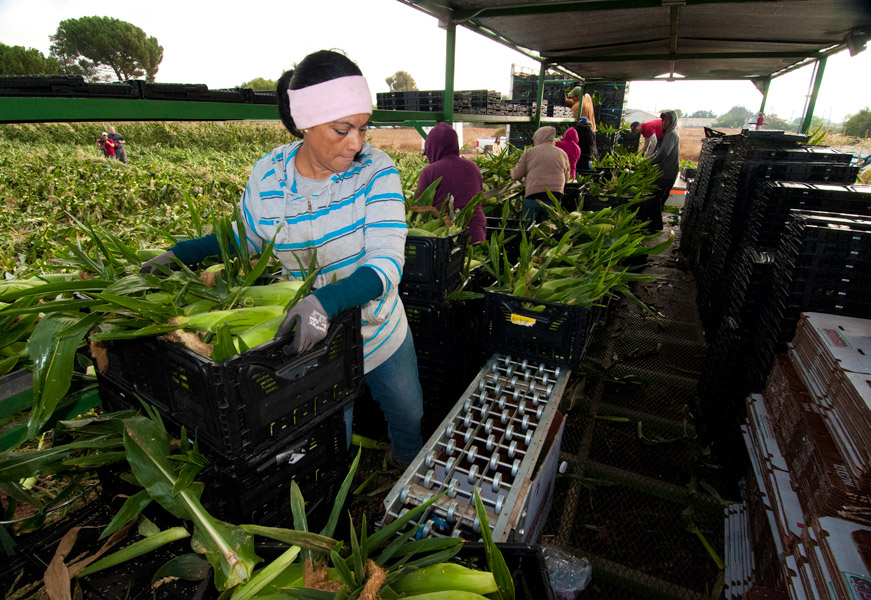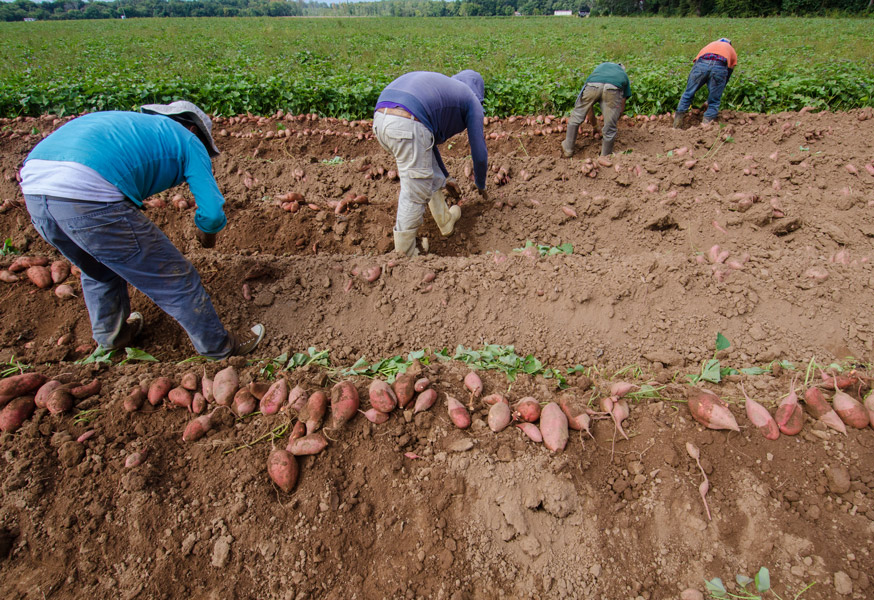We live in an era of unprecedented human migration: Approximately 250 million people live outside the country where they were born. Although millions are forced to leave their homes because of violent conflict or natural disaster, the main reason people immigrate is economic — the search for better-paying work and a brighter economic future.
Many rich countries, such as the United States, and some emerging economies need immigrants to replenish their aging workforce, according to a 2016 report from the World Bank Group. Migrants from the poorest countries can increase their income 15-fold, and in 2015 sent $432 billion in remittances to developing countries, the same report found. Yet immigration can be risky: Many immigrants lose their health — and even their lives — in this global exchange of labor.
Some immigrants perish while traveling to the country where they hope for employment, including hundreds of fatalities in recent years at the United States-Mexico border. Thousands of others are injured at work and exposed to hazardous chemicals or conditions that can cause serious illness and disease. In the United States, the Census of Fatal Occupational Injuries found that immigrant workers were 15 percent more likely to be fatally injured on the job than those who were native-born.
The power imbalance between employers and immigrant workers, who have few rights, forces migrants to take risks that endanger their health, according to occupational health researcher Marc Schenker of the University of California, Davis. Many migrant workers also lack access to proper health care because countries restrict the benefits they can receive, or workers are afraid to claim services that do exist, he says.
Schenker has been studying the health problems of California’s agricultural workers — nearly all of whom are immigrants — for more than 30 years and recently coauthored (with Sally C. Moyce) an article exploring migrant worker health in the Annual Review of Public Health.
Knowable Magazine asked Schenker why migrants are particularly vulnerable to injury and death on the job, and how host countries can protect them. This conversation has been edited for length and clarity.
How did you become interested in studying immigrant worker health?
I've been doing occupational health research for pretty much my whole career. One of the reasons I came to California was an episode in Lathrop, a small town in the Central Valley, where men working at a pesticide-formulating plant became sterile from working with the chemicals there. A pesticide for killing soil worms, called dibromochloropropane (DBCP), was identified as the agent that made the men sterile. It made national news and DBCP was banned.
Migrating for work can be risky: Many immigrants lose their health — and even their lives — in the global exchange of labor.
That event led to the California legislature funding several programs under the Center for Occupational and Environmental Health, including one at UC Davis. After I took a position in that center in 1983, I developed an interest in something called the Latino reproductive paradox. Latinas who immigrate to the US have a worsening rate of preterm, low-birth-weight babies. It’s called a paradox because it’s the opposite of what you might expect to happen when women come to a country with more medical resources. Through that study, I realized that being an immigrant is associated with a whole range of adverse health outcomes, both occupational and non-occupational.
What is the global scale of immigration for work? How big of an issue is immigrant worker health?
If you count both transnational migrants and internal migrants, the number of immigrants worldwide approaches 1 billion — one seventh of the population. If we look in California, 26 percent of our population was born outside the country. One quarter. The largest reason people move is for work, and immigrants work at a higher rate than native-born people.
In general, immigrants tend to work in more hazardous jobs than native-born workers. These jobs are known as the three Ds — dirty, dangerous and disgusting. Now, I know some Silicon Valley immigrant workers who are treated and paid very well. But most immigrant workers are doing jobs native-born people don’t want to do. If you look at the Census of Fatal Occupational Injuries, which tracks work-related fatalities in the United States, you’ll see that three of the most dangerous industries are agriculture, construction and transportation. Those industries also employ some of the highest percentages of migrant workers.
Beyond doing the most dangerous jobs, immigrants are more vulnerable workers. They have lower salaries and fewer rights, and undocumented immigrants face the threat of deportation or losing their jobs. Because of this vulnerability people often take risks at work that they know they shouldn’t. For example, in studies where Latino is probably a surrogate term for being an immigrant, Latino construction workers have more fatalities at work compared to non-Latinos, even though they are doing the same work.
What health risks are of particular concern?
One area I’ve worked on is heat stress injuries among agricultural workers. Heat stress can range from mild symptoms such as faintness to shock and death. Dehydration and clothing both contribute, but these are smaller contributing factors than the heat of metabolism. The harder you work, the greater your body heat load is and the greater the risk. Piecework is an incentive to overwork.
There’s an epidemic of something called “chronic kidney disease of unknown origin” among agricultural workers in tropical areas around the world, including Central America, Sri Lanka, India, El Salvador and other locations. The main hypothesis is that heat stress is the primary contributing factor, although other factors, such as pesticide exposure, may also contribute.
In the US, the Centers for Disease Control and Prevention showed that between 1992 and 2006, the rate of heat stress fatality for agricultural workers was 20 times the average rate of all other civilian occupations. California’s agricultural workforce is 90 percent immigrants, so the burden is falling on the immigrant population. In a recent study of heat stress in California agricultural workers, we looked at kidney function over the course of a work shift. We saw that about 15 percent of the workers developed acute kidney injury — a sudden loss of kidney function or kidney damage that results from and causes buildup of waste products in the blood — over the course of a single shift. This suggests that many workers are at risk for chronic kidney injury, which is the gradual loss of kidney function over time. Eventually it can lead to kidney failure, which requires dialysis or a kidney transplant to treat.
Another concern for many immigrant workers is dust. It’s not considered a toxin, but we’ve found evidence of interstitial fibrosis — scarring of lung tissue — and lung hypersensitivity from inorganic dust exposure. Among women doing domestic work, there are international studies showing increased risk of asthma from inhaling dust and cleaning products. Ergonomic injuries from performing repetitive motions, such as back pain, are also common among domestic workers.
Where is the health of immigrant workers most protected?
There are some countries that are better than others, but I haven’t found any gold star examples. Canada and Israel have immigrant worker programs that are trying to create a balance between protection of employer rights and protection of immigrant worker rights. In general, however, immigrant workers have little to no political power. Employers are the most powerful groups in their countries, and many have a comfortable system that they’re not keen to change.
Where are immigrant workers most vulnerable?
In Middle Eastern countries such as the United Arab Emirates and Qatar, almost the entire workforce is made up of immigrants, mostly from Asia. Many countries have what is called the kafala system, which is basically an indenturement program for workers to their employers. Workers have terrible housing conditions and work conditions, and no recourse because if they complain they can be deported on the spot. The data show a very high toll of occupational fatalities doing construction work, the most common job for immigrant men. For women, the most common job is domestic work, and there are huge abuses.
Is it difficult for immigrant workers to access health services?
There is a myth that immigrants overuse health care and health services in the US. The reality is that immigrant workers underutilize health services such as going to the emergency room or seeing a doctor. This is probably getting worse with the recent immigration crackdowns, which make immigrants afraid to get health care that they are entitled to and need.

USDA PHOTO BY BOB NICHOLS
Recently I have been hearing about a horrendous situation with renal failure — when the kidneys stop working and can no longer effectively clear toxins from the blood. If you have renal failure and you’re symptomatic, legally doctors have to dialyze you in an emergency room. Many immigrants who have renal failure can’t get regular treatment, but when they get sick enough they’ll go to an emergency room and get dialyzed. Sometimes they’ll even accelerate getting sick so that they can get dialysis and get better. It goes against medical practice.
What can countries and states do to help protect immigrant worker health?
Ideally, both the sending country and the receiving country work together to help provide workers with better protections. Within the US, California is probably the most progressive state in terms of immigrant agricultural workers. There are laws giving agricultural workers overtime and increasing minimum wage and other benefits that don’t exist in other parts of the country.

USDA PHOTO BY LANCE CHEUNG
We were also the first state in the country to have a heat stress standard for outdoor workers, which requires employers to provide water, as well as mandatory rest periods and shade triggered by high temperatures: Shade at or above 80 degrees Fahrenheit, and a minimum 10-minute rest to cool off every two hours at or above 95 degrees Fahrenheit. A CDC study found that the death rate from heatstroke among agriculture workers in North Carolina is about five times what it is in California. It’s not five times hotter in North Carolina — the work conditions in California are just better.
Immigration is serving a very positive purpose, by bringing workers from countries where they don’t have work to countries that need workers. The problem is how it’s managed. There shouldn’t be one standard of safety and health for native-born workers and another for immigrant workers. Equity in how workers are treated is the goal.




